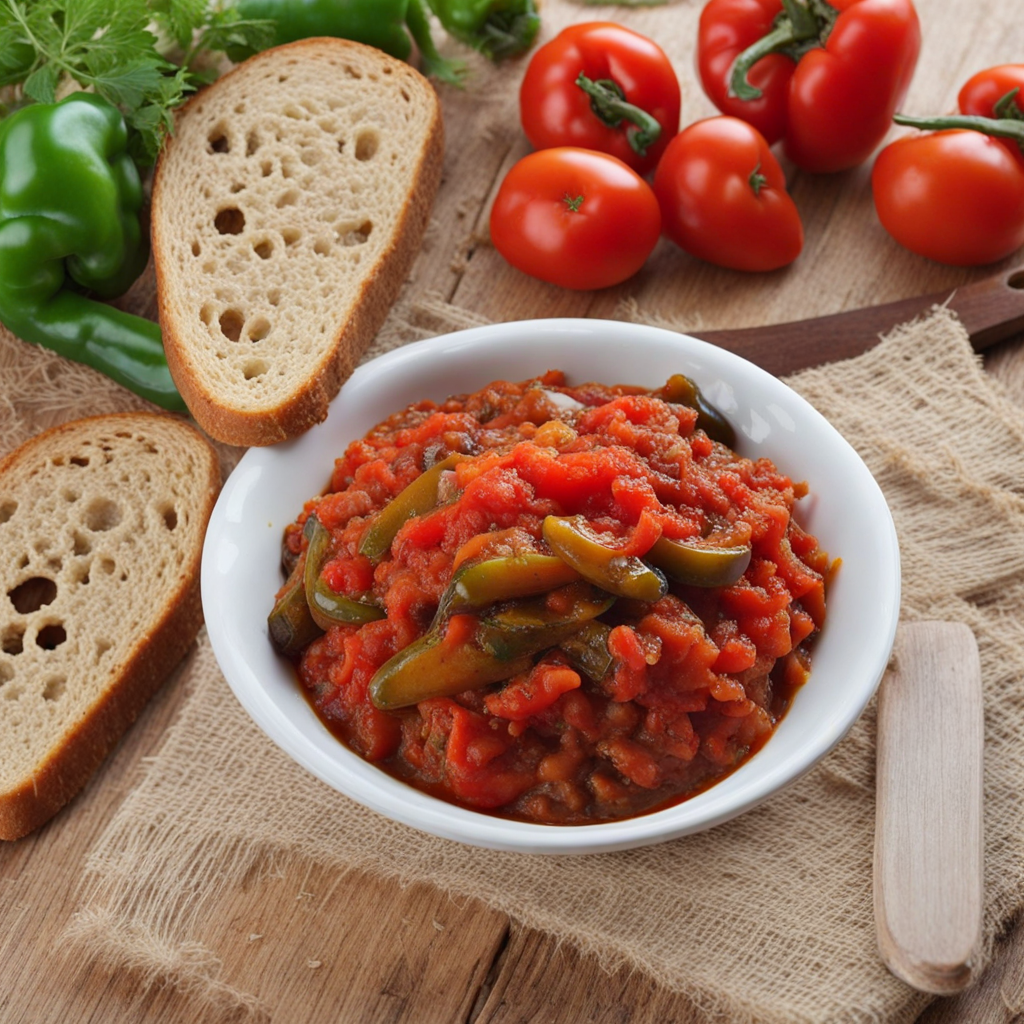Banitsa
Banitsa is a traditional Bulgarian pastry that captures the essence of Bulgarian culinary heritage. It consists of layers of thin, flaky dough, known as 'yufka', which are carefully filled with a delightful mixture of crumbled cheese, typically white brined cheese, eggs, and yogurt. The texture of Banitsa is a harmonious balance between crispy and soft, as the outer layers become golden brown and flaky while the interior remains moist and savory. This dish is often enjoyed fresh out of the oven, the aroma wafting through the air, enticing anyone nearby to take a bite. One of the most appealing aspects of Banitsa is its versatility; it can be made with a variety of fillings beyond the classic cheese and egg mixture. Some versions include spinach, leeks, or pumpkin, catering to different taste preferences and seasonal ingredients. Additionally, it can be served as a hearty breakfast, a savory snack, or even as a side dish during a festive meal. The layers of dough can be artfully arranged in a spiral or rolled into a coil, making each presentation unique and visually appealing. In Bulgaria, Banitsa is not just food; it is a cultural symbol often enjoyed during celebrations and family gatherings. On New Year’s Eve, it is customary to add a lucky charm to the Banitsa, making it a fun and engaging tradition. The dish is commonly paired with yogurt or a glass of ayran, a refreshing yogurt-based drink, enhancing the overall experience. With its rich flavors and comforting textures, Banitsa invites food lovers to explore the heart of Bulgarian cuisine and savor a taste of its rich culinary tradition.
How It Became This Dish
The Intriguing Journey of Баница: A Culinary Treasure of Bulgaria Bulgaria, a nation steeped in history and rich in cultural heritage, boasts a gastronomic tradition that reflects its diverse influences and communal practices. Among the most beloved dishes in Bulgarian cuisine is "баница" (banitsa), a flaky pastry that has captured the hearts and palates of Bulgarians and visitors alike. With origins that stretch back centuries, банница is not merely a culinary delight; it is a symbol of cultural identity, celebration, and community. Origins of Баница The roots of банница can be traced back to the Byzantine Empire, where similar pastries were created using layers of dough and various fillings. The term "баница" itself is believed to derive from the Greek word "bani," which refers to a type of pie or pastry. As the Byzantine influence spread throughout the Balkans, so too did the culinary traditions associated with these layered pastries. In Bulgaria, the evolution of банница began in the medieval period, during which the dish was adapted to local tastes and ingredients. The use of flaky pastry, known as "phyllo" in some cultures, became a defining characteristic of банница. Traditionally, it was made with simple ingredients that were readily available, such as flour, water, and salt. As the dish developed, various fillings emerged, ranging from savory to sweet, reflecting the agricultural bounty of the region. Cultural Significance Баница is not just food; it holds profound cultural significance in Bulgarian society. It is often associated with celebrations, rituals, and family gatherings. One of the most notable occasions for making банница is during the New Year's celebration, particularly on January 1st, when families prepare a special version called "баница с късмети" (banitsa with fortunes). In this tradition, small slips of paper with written fortunes or blessings are hidden within the layers of the pastry. As the family enjoys the банница, each member takes turns to find their fortune, which is believed to predict the coming year's events. In addition to New Year's celebrations, банница plays a prominent role during weddings and other significant life events. The bride often prepares a special банница, symbolizing prosperity and fertility. The act of sharing this dish among guests signifies the couple’s hope for a fruitful and harmonious life together. Varieties and Regional Adaptations As банница spread throughout Bulgaria, various regional adaptations emerged, each with its unique flair. The most common variations include: 1. Баница с сирене (Banitsa with cheese): Perhaps the most popular version, this банница is filled with a mixture of feta cheese (or a similar white cheese), eggs, and yogurt, creating a rich and savory flavor. The cheese gives the pastry a delightful saltiness that complements the flaky layers. 2. Баница с зелеч (Banitsa with greens): In rural areas, particularly during spring, it is common to find банница filled with seasonal greens such as nettles, spinach, or leeks. This version reflects the connection to the land and the importance of using fresh, local ingredients. 3. Баница с ябълки (Banitsa with apples): A sweet variation, this банница is filled with grated apples, sugar, and cinnamon. It is often enjoyed as a dessert or a special treat during festive occasions. 4. Баница с тиква (Banitsa with pumpkin): Another sweet version, this банница incorporates roasted pumpkin, sugar, and walnuts, reflecting the harvest season and the abundance of local produce. The Evolution Over Time As Bulgaria navigated through various historical changes, including Ottoman rule and the influence of neighboring cultures, the tradition of making банница evolved. The Ottoman Empire's culinary practices influenced the preparation of pastries, and the introduction of new spices and ingredients enriched the Bulgarian version of банница. In the 20th century, as Bulgaria underwent industrialization and urbanization, the method of preparing банница began to shift. While many families maintained traditional recipes passed down through generations, commercial bakeries started to produce ready-made банница, making it more accessible to the urban population. This democratization of банница allowed people to enjoy the beloved dish without the labor-intensive process of making it from scratch. Today, банница remains a staple in Bulgarian households and is celebrated at various cultural festivals. It is often featured in food fairs and culinary events, showcasing not only the traditional preparation methods but also innovative interpretations by modern chefs. The dish has transcended its humble origins, becoming a point of pride for many Bulgarians, both at home and in the diaspora. Conclusion Баница is more than just a dish; it is a culinary emblem of Bulgaria's rich history and cultural identity. Its evolution from ancient Byzantine roots to a cherished national treasure reflects the adaptability and resilience of Bulgarian cuisine. The traditions surrounding банница, from the fortunes hidden within to its presence at life’s significant moments, highlight the deep connections between food, family, and community. As Bulgaria continues to navigate the complexities of modern life while honoring its heritage, банница stands as a delicious reminder of the past, a taste of the present, and a symbol of hope for the future. Whether enjoyed at a festive gathering or as a comforting meal at home, банница remains a beloved dish that truly encapsulates the spirit of Bulgarian culture.
You may like
Discover local flavors from Bulgaria







